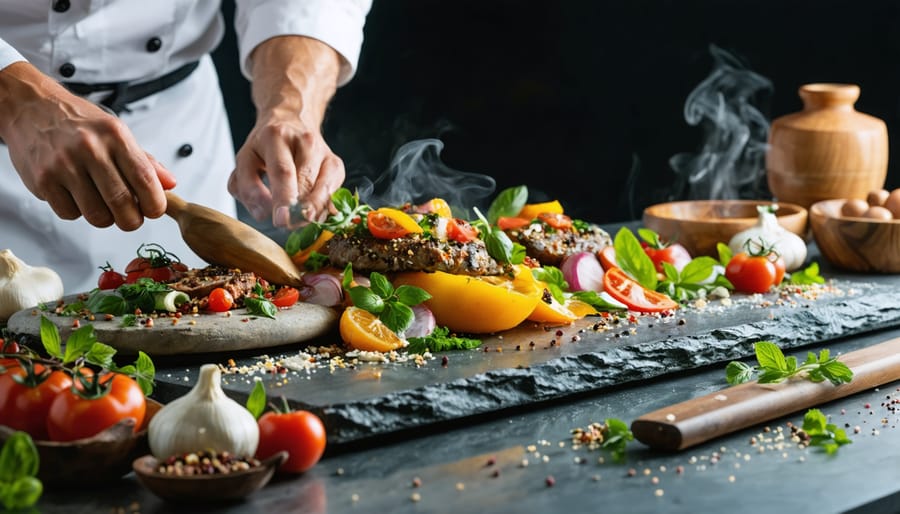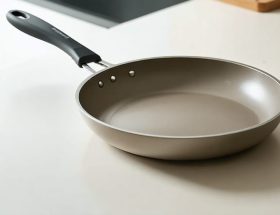Embark on a transformative culinary journey where ancient techniques meet modern gastronomy through the timeless medium of natural stone countertops and cooking surfaces. From the searing heat of volcanic stone plates to the gentle warmth of marble pastry stations, stone’s thermal properties have revolutionized how we prepare, present, and experience food across cultures.
Today’s innovative chefs and home cooks are rediscovering these age-old methods, incorporating heated granite surfaces for perfect sear marks, using chilled marble slabs for tempering chocolate, and exploring salt block cooking for uniquely seasoned dishes. This marriage of traditional wisdom with contemporary cuisine opens up endless possibilities for flavor development, texture manipulation, and presentation excellence.
As we delve into the world of culinary stone applications, we’ll uncover how different stone types interact with various ingredients, master temperature control techniques, and learn why professional kitchens worldwide still rely on these ancient cooking surfaces. Whether you’re a seasoned chef or an adventurous home cook, understanding these fundamental principles will elevate your cooking to new heights of sophistication and authenticity.
The Ancient Art of Stone Cooking
Traditional Stone Cooking Methods
Stone cooking methods have been foundational to human culinary development for thousands of years. Ancient civilizations discovered that heated stones could retain and distribute heat evenly, leading to the development of various cooking techniques still relevant today. Hot stone cooking, where heated rocks are used to cook food directly or warm cooking vessels, emerged independently across multiple cultures, from Native American tribes to Pacific Islander communities.
One notable technique is the earth oven or “hot rock” method, where stones are heated in a fire, then used to line a pit where food is placed and covered. This method creates a natural convection oven, perfect for slow-cooking meats and vegetables. In Polynesian cultures, the similar “umu” technique involves wrapping food in leaves before placing it among hot stones.
Stone griddles, or cooking slabs, represent another traditional approach. These flat stones, typically granite or basalt, were placed over fire to create an early form of griddle cooking. This method proved particularly effective for preparing flatbreads, vegetables, and proteins, offering consistent heat distribution and natural non-stick properties that modern stone cookware still aims to replicate.
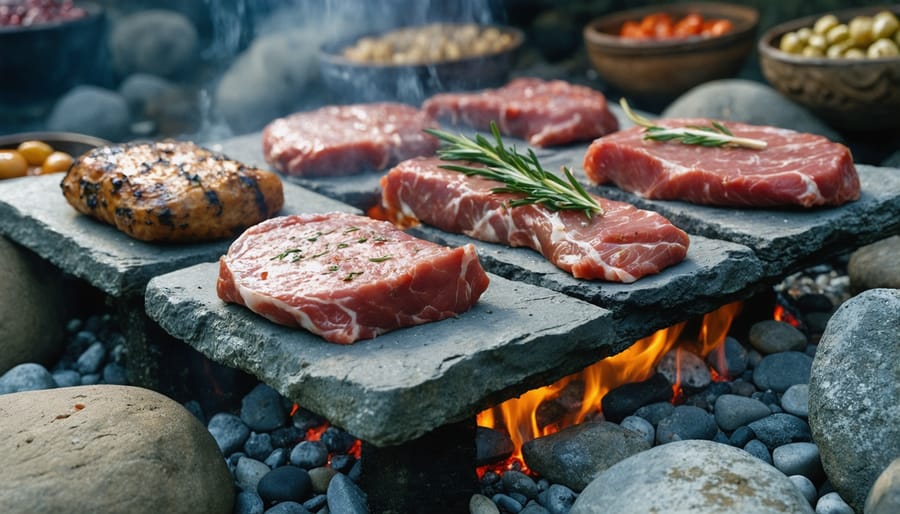
Modern Revival of Stone Cooking
Contemporary chefs and home cooks are rediscovering the unique qualities of stone-based cooking, adapting ancient techniques for modern kitchens. Hot stone cooking, which dates back thousands of years, is experiencing a renaissance in high-end restaurants and innovative home settings. Chefs are incorporating heated granite and basalt slabs for tableside cooking, allowing diners to sear their proteins to perfection while enjoying the theatrical element of the experience.
Modern stone cooking equipment has evolved to include precision-cut stone plates with specialized heating elements, making it safer and more convenient than traditional methods. These innovations maintain the authentic cooking properties of stone while meeting current safety standards and culinary expectations.
The farm-to-table movement has particularly embraced stone cooking for its ability to enhance natural flavors without additional fats or oils. Salt blocks, a subset of stone cooking, have gained popularity for their ability to impart subtle mineral flavors while cooking and serving foods. Professional kitchens are also incorporating permanent stone cooking stations, featuring temperature-controlled surfaces that can maintain consistent heat for hours of service.
Natural Stone Surfaces for Modern Cooking
Marble: The Baker’s Choice
For centuries, professional bakers have sworn by marble as their preferred work surface, and for good reason. The naturally cool temperature of marble, typically maintaining 5-10 degrees below room temperature, makes it ideal for handling temperature-sensitive doughs and pastry making techniques. This inherent coolness prevents butter from melting too quickly, ensuring perfect lamination in croissants and other layered pastries.
The smooth, non-porous surface of marble provides an excellent platform for rolling out dough, tempering chocolate, and creating delicate sugar work. When working with chocolate, marble’s ability to maintain consistent temperatures helps achieve the perfect crystallization needed for that coveted glossy finish and satisfying snap.
While caring for marble surfaces requires attention to prevent staining and etching, the benefits for serious bakers far outweigh the maintenance needs. The surface’s natural cooling properties eliminate the need for frequent trips to the refrigerator during preparation, making it particularly valuable during summer months or in warm kitchen environments.
Professional pastry chefs particularly appreciate marble’s heat-resistant properties when working with sugar and caramel, as the surface won’t warp or damage under extreme temperature changes. This versatility, combined with its timeless elegance, makes marble an invaluable tool in both professional and home kitchens.
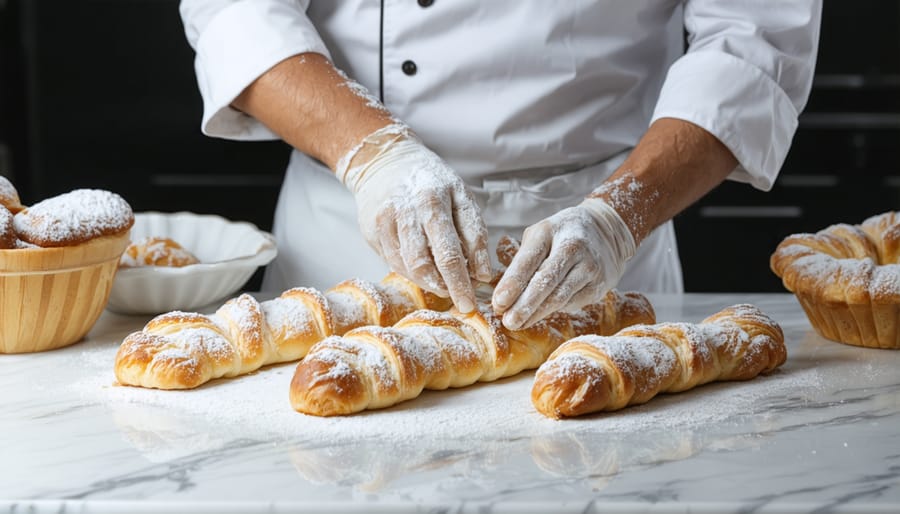
Granite: The All-Purpose Powerhouse
Granite’s remarkable versatility in the kitchen makes it an unmatched surface for culinary enthusiasts. This natural stone effortlessly transitions between hot and cold temperatures, making it ideal for various cooking techniques. From rolling out delicate pastry dough to serving as a cooling surface for tempering chocolate, granite’s thermal properties work to your advantage.
The dense crystalline structure of granite provides exceptional durability, allowing it to withstand the rigors of daily food preparation without scratching or staining. Its non-porous nature, when properly sealed, prevents bacterial growth and makes cleanup a breeze. Whether you’re pounding meat, kneading bread, or chopping vegetables, granite maintains its integrity while providing a stable work surface.
Professional chefs particularly value granite’s heat resistance. You can place hot pots directly on the surface without worry, and its natural cooling properties make it perfect for pastry work. The stone maintains a consistently cool temperature, essential for working with butter-based doughs and confections.
For home cooks, granite offers the perfect balance of functionality and elegance. Its varied color patterns and natural beauty add visual interest to your kitchen while serving as a reliable workstation. The smooth, polished surface allows for easy movement of kitchen tools and provides excellent stability for precise cutting and chopping tasks.
Soapstone: The Heat Master
Soapstone stands out as nature’s premier heat conductor and retainer in the culinary world. This remarkable material, composed primarily of talc and magnesite, possesses unique thermal properties that make it invaluable for cooking enthusiasts and professional chefs alike. Once heated, soapstone maintains a consistent temperature for extended periods, allowing for even cooking and superior heat distribution.
Unlike metal cookware that can create hot spots, soapstone gradually releases its stored heat, ensuring food cooks uniformly from all sides. This steady heat release makes it particularly effective for slow-cooking dishes, braising meats, and maintaining serving temperatures for extended periods. The dense structure of soapstone can retain heat for up to an hour after being removed from the heat source, making it an energy-efficient choice for both cooking and serving.
The non-porous nature of soapstone means it won’t absorb flavors, odors, or bacteria, making it both hygienic and easy to maintain. Its natural non-stick properties eliminate the need for excessive oils or cooking sprays, contributing to healthier cooking practices. When properly seasoned, soapstone develops a natural patina that enhances its non-stick qualities while preserving its heat retention capabilities.
Whether used as a cooking surface, serving platter, or pizza stone, soapstone’s thermal properties consistently deliver superior culinary results, making it a valuable addition to any kitchen arsenal.
Cooking Techniques Enhanced by Natural Stone
Temperature Control and Heat Distribution
Natural stone’s unique thermal properties make it an exceptional medium for temperature control in culinary applications. Different types of stone conduct and retain heat differently, creating distinct cooking environments that can enhance food preparation. Granite, for instance, maintains consistent temperatures once heated, making it ideal for slow-cooking and even heat distribution. This characteristic helps prevent hot spots that often plague metal cookware.
The dense crystalline structure of natural stone allows it to absorb heat gradually and release it steadily, a property that professional chefs particularly value. When cooking on stone surfaces, foods cook more evenly from bottom to top, resulting in better texture and more consistent results. This is especially beneficial for items like pizzas, breads, and delicate proteins that require precise temperature control.
Marble, with its lower heat conductivity, excels in pastry preparation by maintaining cooler temperatures longer. This makes it the preferred surface for chocolate tempering and dough rolling. Conversely, materials like soapstone offer superior heat retention, making them excellent for long-term cooking projects or keeping dishes warm during service.
The thermal mass of natural stone also contributes to energy efficiency in cooking. Once heated, stone surfaces require less energy to maintain temperature compared to conventional cooking materials. This natural temperature regulation helps create optimal cooking conditions while reducing energy consumption. For home cooks and professionals alike, understanding these thermal properties allows for better control over cooking processes and ultimately leads to superior culinary results.
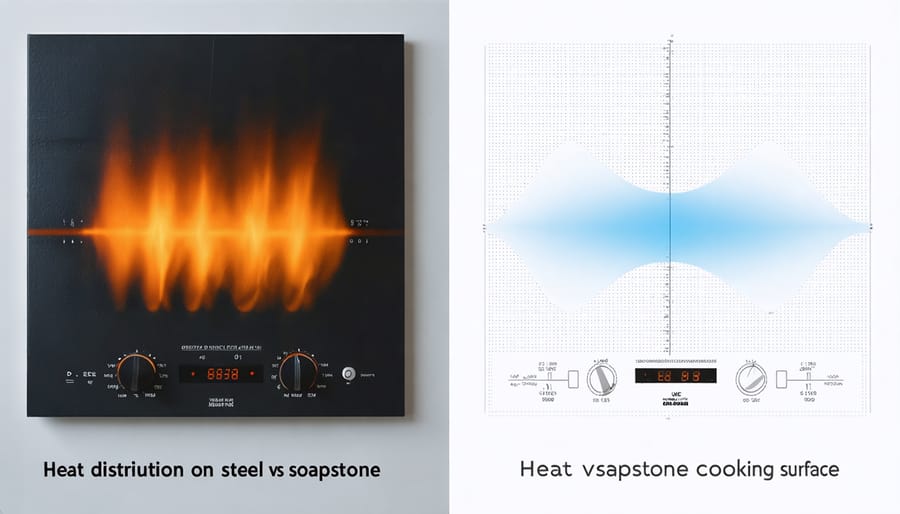
Surface Interactions and Flavor Development
The interaction between food and stone surfaces creates a unique culinary experience that goes beyond mere preparation. Natural stone’s thermal properties allow for exceptional heat distribution, creating consistent cooking temperatures that enhance food texture and flavor development. When proteins come into contact with a properly heated stone surface, they undergo the Maillard reaction more effectively, producing complex flavor compounds and that coveted golden-brown crust on meats and vegetables.
Stone surfaces, particularly granite and soapstone, retain heat longer than conventional cooking materials, allowing for more controlled cooking temperatures. This steady heat transfer helps preserve food’s natural moisture while developing deeper, more complex flavors. The microscopic pores present in natural stone surfaces also contribute to texture development by creating minimal but crucial air pockets between the food and cooking surface.
Traditional cooking methods using hot stones, such as Korean dolsot bowls and Japanese ishiyaki, demonstrate how stone’s properties enhance dish-specific flavors. In dolsot preparations, the stone bowl continues cooking the rice, creating a beloved crispy bottom layer while keeping the upper portions warm and tender. Similarly, when using stone mortars for grinding spices or making pestos, the material’s natural texture aids in releasing essential oils and combining ingredients more thoroughly than mechanical processors.
The slightly alkaline nature of some stone surfaces can also influence food’s chemical composition during preparation, particularly when working with acidic ingredients like tomatoes or citrus. This interaction can result in subtle flavor modifications that experienced chefs often leverage to achieve specific taste profiles in their dishes.
Maintaining Your Stone Cooking Surfaces
Proper maintenance of your stone cooking surfaces is essential for both their longevity and optimal culinary performance. Following established stone surface cleaning and care guidelines will ensure your stone surfaces remain safe for food preparation and maintain their natural beauty.
After each use, allow your stone surface to cool completely before cleaning. Use warm water and a soft cloth or sponge to remove food residue, avoiding harsh scrubbing that could damage the stone. For stubborn spots, create a paste using baking soda and water, applying it gently to the affected area.
Never use acidic cleaners, vinegar, or citrus-based solutions on your stone surfaces, as these can etch and damage the material. Commercial cleaners specifically formulated for natural stone are your best option for regular maintenance. Always test new cleaning products on a small, inconspicuous area first.
To prevent staining, seal your stone surfaces regularly according to manufacturer recommendations, typically every 6-12 months. This creates a protective barrier against oils, wines, and other potentially staining substances common in kitchen environments.
For pizza stones and cooking slabs, avoid sudden temperature changes that could cause thermal shock and cracking. Never place a cold stone in a hot oven or vice versa. Instead, allow the stone to heat up gradually with the oven.
Store your stone cooking implements in a dry, well-ventilated area to prevent moisture accumulation. If using storage racks, ensure they’re sturdy enough to support the weight of your stone pieces. Consider placing felt or rubber padding between stone surfaces and metal racks to prevent scratching.
With proper care, your stone cooking surfaces can provide decades of reliable service, enhancing your culinary adventures while maintaining their natural beauty and functionality.
Natural stone’s integration into culinary spaces offers more than just aesthetic appeal – it fundamentally enhances the cooking experience and food preparation process. From the durability of granite countertops to the heat retention of marble pastry surfaces, each stone type brings unique properties that benefit both home cooks and professional chefs. The timeless elegance of natural stone creates an inviting atmosphere that elevates everyday cooking into a more engaging and enjoyable experience. Whether it’s the traditional charm of a stone pizza oven or the practical functionality of a stone mortar and pestle, these elements connect us to centuries of culinary tradition while providing modern convenience and reliability. By incorporating natural stone into your kitchen, you’re not just investing in beautiful, long-lasting materials – you’re enhancing your entire culinary journey with surfaces that perform as impressively as they look.

